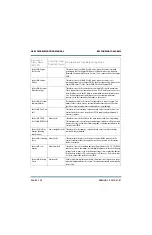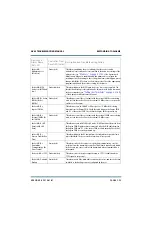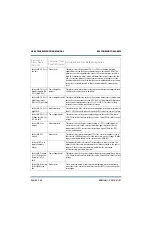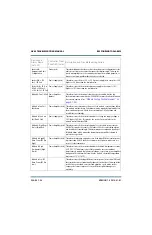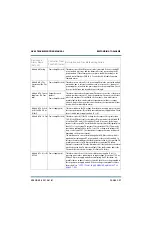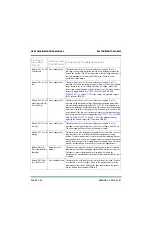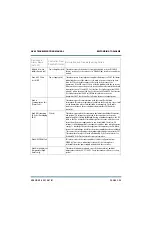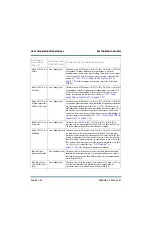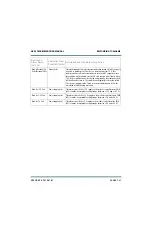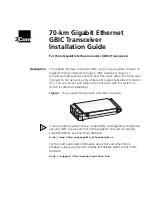
GV60 TROUBLESHOOTING MANUAL
RESPONDING TO ALARMS
PAGE 4.1.28
VERSION 1.0 2018-01-01
Module #: PS A (or B)
Current Limit
Power Supply (red)
This alarm occurs if one of the two module power supplies (1 or 2) is
reporting a current limit, indicating that the power being delivered by the
module has reached 2750 W. This may relate to the operating mode and/or
the load impedance at the transmitter’s RF output. Check for other
transmitter related alarms.
Module #: PS A (or B)
Fail
Power Supply (red)
This alarm occurs if one of the two module power supplies (1 or 2) is
reporting a PS failure, indicating its output voltage is outside its acceptable
range, based on the control setting. Check the dc voltage output of the
suspect power supply module. If the dc voltage is out of tolerance, replace
the power supply module (see
). If the voltage is acceptable, suspect
the PS interface PWB (A1).
Module #: PS A (or B)
High Temperature [PS
A (or B) Temp]
Power Supply (red)
This alarm occurs if one of the two module power supplies (1 or 2) is
reporting a high temperature alarm, indicating its operating temperature
has exceeded its internal threshold of 105°C (221°F). Both module power
supplies are inhibited while this fault exists. This alarm is most likely caused
by a module fan failure or blockage. Verify the module turns on and its fan
is operational. If the fan is not operational, inspect it for possible blockage.
If necessary, replace the power supply module (see
Module Replacement” on page 4.1.50
). If the alarm persist after
replacing the module, suspect the PS interface PWB (A1).
Module #: PS A (or B)
Low Line
Power Supply (red)
This alarm occurs if one of the two module power supplies (1 or 2) is
reporting a low ac input voltage (less than 175 V ac, higher than 90 V ac).
The power supply will limit its associated module’s output.
Module #: PS A (or B)
Missing
Power Supply (red)
This alarm occurs if the module power supply (A or B) is removed, or has not
been detected on the serial bus. Install an operational power supply
module. The alarm may persist for several seconds after replacing a power
supply module, before the power supply module is recognized. If the alarm
persists after one minute, try reseating the power supply module. This alarm
may also be caused by an ac power loss to the power supply module.
Module #: Reject
Power Shutback (Rej
Shutback)
Output Network
(amber)
This alarm occurs when the reject power in the power module’s combiner
suddenly exceeds 600 W, requiring a shutback. This may be the result of a
PA failure or, under certain conditions, may indicate a fault in the
transmitter’s RF combiner/filter. The module will be latched off until a reset
is initiated.
Module #: RF Drive
Loss (RF Drv Loss)
Power Amplifier (red) This alarm occurs if the input RF drive (exciter power) is less than 1 W when
it is expected to be 2 W or higher, based on the measurements from the
remaining power modules. Check the RF drive cable between the splitter
and the module control/interface PWB (A3).
Device and
Alarm Name
(AUI, UI)
Controller Front
Panel LED (color)
Description and Troubleshooting Action
Содержание GV60
Страница 2: ......
Страница 4: ......
Страница 8: ...GV60 TROUBLESHOOTING MANUAL PAGE 4 VIII VERSION 1 0 2018 01 01 ...
Страница 102: ...GV60 TROUBLESHOOTING MANUAL PARTS LISTS PAGE 4 2 12 VERSION 1 0 2018 01 01 ...
Страница 463: ...VERSION 1 0 2018 01 01 MD 17 Figure MD 17 NAPA31C Power Amplifier PWB Q1 ...
Страница 466: ...VERSION 1 0 2018 01 01 MD 20 Figure MD 20 NAI23A RF Drive Splitter Changeover Assembly FRONT BACK ...
Страница 473: ...VERSION 1 0 2018 01 01 MD 27 Figure MD 27 NAL17 4 Input Reject Load Assembly TOP VIEW END VIEW 2 INPUT REJECT PWB A1 ...
Страница 475: ...GV60 TROUBLESHOOTING MANUAL LIST OF TERMS PAGE 4 6 2 VERSION 1 0 2018 01 01 ...
Страница 476: ......









